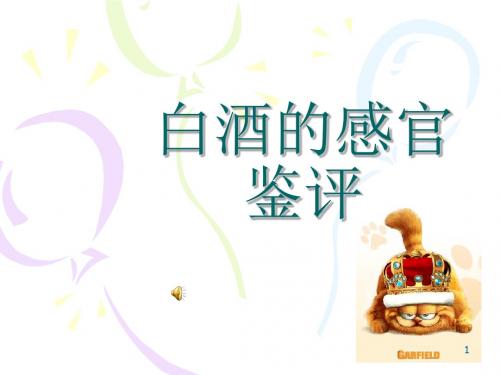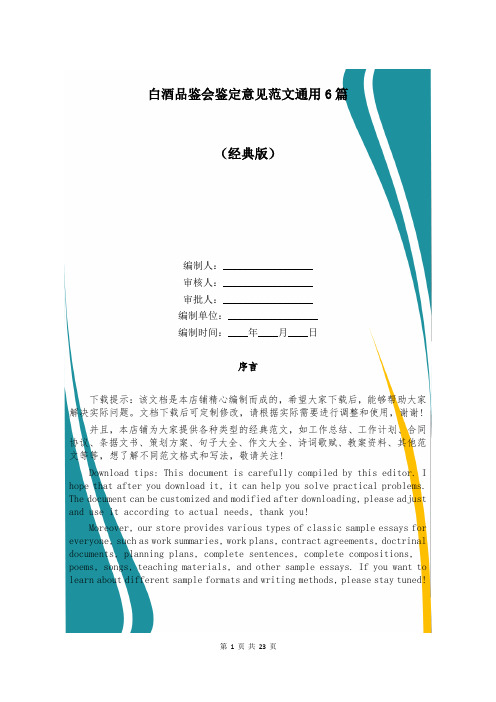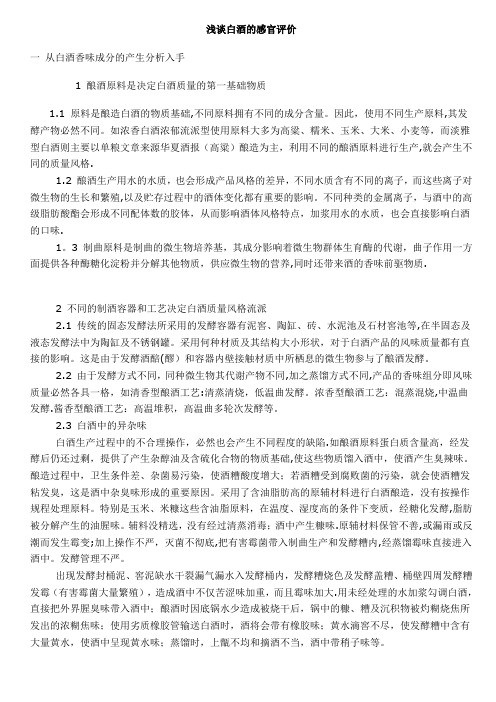白酒的感官鉴评共25页
白酒的感官评定2111454110程柯

教学单位生物化学系存档编号本科论文题目白酒的感官评定学生姓名程柯学生学号 2111454110 专业名称生物工程指导教师许爱华2013年6月23日内容摘要:白酒做为世界上的八大蒸馏酒之一,有着比其他酒类更悠久的历史,在工艺上也比世界各国的蒸馏酒都复杂得多,原料各种各样,酒的特点也各有风格,酒名也五花八门。
随着现代社会发展和人们的生活水平的不断提高,依据白酒的产品质量标准对白酒的感官评定也建立了完善的评价体系。
在产品的质量标准中明确了规定了白酒感官标准的技术要求。
本文对白酒的感官评定做出了详细的总结,对白酒感官评定方法及特点做出了相应的介绍。
关键词:白酒;质量评价体系;感官评定前言 (3)一、白酒发展的历史 (3)1、酒的起源 (3)2、白酒的发展 (3)3、现代酒的发展 (3)二、中国白酒质量技术标准 (4)1、中国白酒质量技术标准体系的主要发展阶段 (4)2、中国白酒产品质量技术标准的创立过程 (4)三、建立白酒的感官评定体系 (5)1、从白酒香味成分的产生分析入手酿酒原料是决定白酒质量的第一基础物质 (5)2、不同的制酒容器和工艺决定白酒质量风格流派 (5)3、白酒中的异杂味 (5)4、借鉴“香“ (6)四、白酒的感官评定 (8)1、基本原理 (8)2、白酒品评的要求 (8)3、白酒感官评定的基本方法: (9)4、白酒品评的具体方法 (10)结语 (11)参考文献 (11)前言感官评价是指用于唤起、测量、分析和解释产品通过视觉、嗅觉、触觉、味觉和听觉所引起反应的一种科学方法。
感官评价包含一系列精确测定人对食品反应的技术,把对品牌和一些其他信息对消费者影响降到最低。
同时,努力解析食品本身的感官特性,并向产品开发者、食品科学家和管理人员提供关于其产品感官性质的重要而有价值的信息。
感官评价技术在开发产品、研究基础理论、配料和调整工艺、降低成本、控制品质和优化产品等工作中提供着重要的服务。
这些服务能给企业决策提供信息,降低决策风险。
白酒的感官品定

白酒的感官品定感官评价是指用于唤起、测量、分析和解释产品通过视觉、嗅觉、触觉、味觉和听觉所引起反应的一种科学方法.感官评价包含一系列精确测定人对食品反应的技术,把对品牌和一些其他信息对消费者影响降到最低.同时,努力解析食品本身的感官特性,并向产品开发者、食品科学家和管理人员提供关于其产品感官性质的重要而有价值的信息.感官评价技术在开发产品、研究基础理论、配料和调整工艺、降低成本、控制品质和优化产品等工作中提供着重要的服务。
这些服务能给企业决策提供信息,降低决策风险.白酒厂家有一套感官检验程序,有助于确保满足消费者的期望(既有良好的质量又有满意的感官品质的产品进入市场)。
感官评定是一个发展中的领域,它主要研究利用人来测量感官的感知及这种感知对食物和口味接受性的影响。
感官评定方法在经济学上也非常有用。
感官评定可以确定商品的价值,甚至它的可接受性.它可以帮助我们选择最合理的路线,得到最佳的价值价格比。
感官评定主要应用在质量控制、产品研究和开发方面。
感官评定不但在仪器的定位和评估中非常有用,在其他领域也有用处。
感官评定的基本功能就是进行有效、可靠的检验测试,为正确合理的决定提供依据。
中国白酒质量技术标准体系的形成主要经历了两个重要的发展阶段。
一是质量标准的研究创立阶段,二是质量技术标准体系的建立形成阶段。
在整个中国白酒质量技术标准体系的创立、完善、发展过程中,既很好地保护了我国特色传统酒钟,也有力地推动了我国白酒行业的健康发展.原料是酿造白酒的物质基础,不同原料拥有不同的成分含量。
因此,使用不同生产原料,其发酵产物必然不同.如浓香白酒浓郁流派型使用原料大多为高粱、糯米、玉米、大米、小麦等,而淡雅型白酒则主要以单粮(高粱)酿造为主,利用不同的酿酒原料进行生产,就会产生不同的质量风格.酿酒生产用水的水质,也会形成产品风格的差异,就比如贵州茅台镇的茅台,湟金梦,黔星古窖等白酒就与其他地区的不同,不同水质含有不同的离子,而这些离子对微生物的生长和繁殖,以及贮存过程中的酒体变化都有重要的影响。
简述白酒的感官检验方法

简述白酒的感官检验方法白酒的感官检验方法是评价一款白酒的质量和特点的重要手段。
通过感官检验,可以对白酒的外观、香气、口感等方面进行评估,从而提供对酒品的客观判断和分析。
首先,感官检验的第一步是观察白酒的外观。
外观是一款白酒的第一印象,它可以反映出白酒的品质和加工工艺。
观察外观时需要注意酒液的透明度、色泽和光泽。
好的白酒应该呈现出透明、清澈、色泽鲜亮的状态,没有悬浮物和杂质。
其次,感官检验的第二步是评估白酒的香气。
香气是白酒的重要组成部分,可以反映酒品的品质和原料的特点。
评估香气时可以通过嗅闻的方式来感受白酒散发出的香味。
一般来说,优质白酒的香气应该是清新、纯净、丰富而不浓烈的。
香气的种类可以分为酒香、酱香、腥香、芳香等,不同的白酒可能具有不同的香气特点。
感官检验的第三步是品尝白酒的口感。
口感是白酒的质量和特点的重要体现,包括入口感受、味道和余味等方面。
品尝白酒时,可以先用舌尖轻轻舔唇,感受酒液的粘度和润滑度;然后采用含饮的方式,让白酒在口中停留一段时间,感受酒液的刺激度、酸甜苦辣的味道和口感的层次变化;最后,吞咽酒液后留意酒液在口腔中的余味,判断酒液的回味和持久性。
另外,感官检验时还可以结合视觉、嗅觉和味觉的联合作用,进行综合评估。
例如,品尝白酒时可以注视酒液的流动情况、包装的形象以及品牌的声誉;嗅闻酒液时可以结合香气的种类和强度,与品牌的宣传相印证;品味酒液时可以结合口感的变化和持久性,与产品销售价格相比较。
总之,白酒的感官检验方法是一种综合分析白酒品质和特点的重要手段。
通过仔细观察、准确嗅闻和细致品味,可以对白酒进行客观评估和判断,为白酒消费者提供选择和评价的参考依据。
白酒的感官鉴评ppt课件

6.记分标准
• 表1色泽与香气记分标准及表2口味与风格 记分标准。
8
表1 色泽与香气记分标准
色泽 无色透明 混浊 沉淀 悬浮物 分数 +10 -4 -2 -2 香气 具备固定香型的香气特点 放香不足 香气不纯 香气不足 带有异香 有不愉快气味 有杂醇油气味 有其它臭气 注:“+”表示加分,“-”表示扣分。
• 闻评时可根据个人嗅觉 器官的灵敏情况和耐力 进行闻评。如果耐力强, 可按上面闻评方法再重 新闻评一次、二次结果 相对照,对意见不同的 重新闻评。这样可以防 止顺效应、后效应、顺 序效应和个人印象的差 错。
16
对不同香型酒混在一起品评时, 闻评则更为重要。闻评时首先 分出各编号属于那种香型,而 后再按清香型、米香型、酱香 型、浓香型、其它香型的顺序 各自依次进行闻评。对不能确 定香型的酒样,在尝评时综合 确定。闻评时发现有不是本轮 次的香型酒样,放到最后单独 去闻评。为确保嗅闻结果的准 确,可采用把酒滴在手心或手 背上,靠手的温度使酒挥发来 闻其香气,或把酒倒掉,放置 10~15min后嗅闻空杯。后一 种方法是确定酱香型白酒空杯 留香的惟一方法。
6
5.评定方法
• (1)色泽:将样品注入洁净、干燥的品酒杯中, 在明亮处观察,记录其色泽、清亮程度、沉淀及 悬浮物情况。 • (2)香气:将样品注入洁净、干燥的品酒杯中, 先轻轻摇动酒杯,然后用鼻进行闻嗅,记录其香 气特征。 • (3)口味:将样品注入洁净、干燥的酒杯中,喝 入少量样品(约2ml)于口中,以味觉器官仔细 品尝,记录口味特征。 • (4)风格:通过品尝香与味,综合判断是否具有 该产品的风格特征,并记录其强、弱程度。
12
• 酒色的评语一般用无色、清澈透明、微黄 色、黄色、微浑浊、较透明、有沉淀、有 渣滓等术语来表示。酒色的国家标准是: 无色透明给10分,酒色不正常应扣分,有 浑浊现象扣3~4分,沉淀和悬浮物扣2~5 分,色泽过黄或不能显示透明扣2分。总之, 应根据实际情况酌情给分。
白酒的感官评定方法(讲稿)(5篇)

白酒的感官评定方法(讲稿)(5篇)第一篇:白酒的感官评定方法(讲稿)品质量感观鉴别---酒水类1、酒类的感官鉴别要点在感官鉴别酒类的真伪与优劣时,应主要着重于酒的色泽、气味与滋味的测定与评价。
对瓶装酒还应注意鉴别其外包装和注册商标。
对啤酒进行感官检查时,应首先注意到啤酒的色泽有无改变,失光的啤酒往往意味着质量的不良改变,必要时应该用标准碘溶液进行对比,以观察其颜色深浅,开瓶注入杯中时,要注意其泡沫的密聚程度与挂杯时间。
酒的气味与滋味是评价酒质优劣的关键性指标,这种检查和品评应在常温下进行,并应在开瓶注入杯中后立即进行。
4、感官鉴别白酒的基本方法白酒又称蒸馏酒,它是以富含淀粉或糖类成分的物质为原料、加入酒曲酵母和其他辅料经过糖化发酵蒸馏而制成的一种无色透明、酒度较高的饮料。
人们在饮酒时很重视白酒的香气和滋味,目前对白酒质量的品评是以感官指标为主的,即是从色、香、味三个方面来进行鉴别的。
(1)色泽透明度鉴别白酒的正常色泽应是无色透明,无悬浮物和沉淀物的液体。
将白酒注入杯中,杯壁上不得出现环状不溶物。
将酒瓶倒置,在光线中观察酒体,不得有悬浮物、浑浊和沉淀。
冬季如白酒中有沉淀可用水浴加热到30~40℃,如沉淀消失为正常。
白酒的变色:用未经涂蜡的铁桶盛放呈酸性的白酒,铁质桶壁容易被氧化、还原为高铁离子或低铁离子的化合物,从而使酒变成黄褐色。
使用含锌的铝桶,也会使之与酒类中的酸类发生氧化作用而生成氧化锌,使酒变为乳白色。
(2)香气鉴别在对白酒的香气进行感官鉴别时,最好使用大肚小口的玻璃杯,将白酒注入杯中稍加摇晃,即刻用鼻子在杯口附近仔细嗅闻其香气。
或倒几滴酒在手掌上,稍搓几下,再嗅手掌,即可鉴别香气的浓淡程度与香型是否正常。
白酒的香气可分为:溢香——酒的芳香或芳香成分溢散在杯口附近的空气中,用嗅觉即可直接辨别香气的浓度及特点。
喷香——酒液饮入口中,香气充满口腔。
留香——酒已咽下,而口中仍持续留有酒香气。
一般的白酒都应具有一定的溢香,而很少有喷香或留香。
白酒品鉴会鉴定意见范文通用6篇

白酒品鉴会鉴定意见范文通用6篇(经典版)编制人:__________________审核人:__________________审批人:__________________编制单位:__________________编制时间:____年____月____日序言下载提示:该文档是本店铺精心编制而成的,希望大家下载后,能够帮助大家解决实际问题。
文档下载后可定制修改,请根据实际需要进行调整和使用,谢谢!并且,本店铺为大家提供各种类型的经典范文,如工作总结、工作计划、合同协议、条据文书、策划方案、句子大全、作文大全、诗词歌赋、教案资料、其他范文等等,想了解不同范文格式和写法,敬请关注!Download tips: This document is carefully compiled by this editor. I hope that after you download it, it can help you solve practical problems. The document can be customized and modified after downloading, please adjust and use it according to actual needs, thank you!Moreover, our store provides various types of classic sample essays for everyone, such as work summaries, work plans, contract agreements, doctrinal documents, planning plans, complete sentences, complete compositions, poems, songs, teaching materials, and other sample essays. If you want to learn about different sample formats and writing methods, please stay tuned!白酒品鉴会鉴定意见范文通用6篇白酒品鉴会鉴定意见范文第一篇---邪杂气味,溢香性又好,一倒出就香气四溢,芳香扑鼻的,说明酒中的香气物质较多。
白酒品评标准-品酒标准

白酒品评标准-品酒标准1、品酒标准的主要依据品酒标准的主要依据是产品质量标准。
本标准严格按照GB/T10345—2007中感官评定的要求,并以我公司产品质量标准为依据而制定。
2、品酒标准根据GB/T 10345—2007中感官评定的要求,将白酒的品酒标准分述如下:1.色泽:将样品注入洁净、干燥的品酒杯中(注入量为品酒杯的1/2—2/3),在明亮处观察,记录其色泽、清亮程度、沉淀及悬浮物情况。
2.香气:将样品注入洁净、干燥的品酒杯中(注入量为品酒杯的1/2—2/3),先轻轻摇动酒杯,然后用鼻嗅闻,记录其香气特征。
3.口味:将样品注入洁净、干燥的品酒杯中(注入量为品酒杯的1/2—2/3),喝入少量样品于口中,以味觉器官仔细品尝,记下口味特征。
4.风格:通过香和味的品评,综合判断是否具有该产品的风格特征,并记录其典型性程度。
3、记分标准记分标准采用100分为满分,其中色10分,香25分,味50分,格15分。
1.色泽(10分)无色透明 +10分混浊 -4分沉淀 -2分悬浮物 -2分带色(除微黄色外) -2分2.香气(25分)具备本香型特征 +25分清香较纯正 -1分清香正 -2分清香较正 -3分清香尚正 -4分清香欠正 -5分清香带异香 -4分清香较弱、放香不足 -3分有不愉快的气味 -3分3.口味(50分)具有本香型口味特点 +50分欠绵软 -2分欠回甜 -2分淡薄 -2分冲辣 -3分后味短 -2分后味淡 -2分后味苦 -3分涩味 -5分焦糊味 -3分辅料味 -5分稍子味 -5分杂醇油味 -5分糠腥味 -5分其他邪杂味 -6分4.风格(15分)具有本香型的特有风格 +15分风格较明显 -2分风格尚好、一般 -3分错格 -5分偏格 -5分。
白酒感官评价

Sensory properties of cocoa liquor as affected by polyphenol concentration and duration of roastingMisnawi a ,S.Jinapa,*,B.Jamilah b ,S.Nazamidaa Department of Food Science,Faculty of Food Science and Biotechnology,Universiti Putra Malaysia,43400UPM Serdang,Selangor,Malaysia bDepartment of Food Technology,Faculty of Food Science and Biotechnology,Universiti Putra Malaysia,43400UPM Serdang,Selangor,MalaysiaReceived 21April 2003;received in revised form 12July 2003;accepted 18July 2003AbstractSensory properties of cocoa liquor roasted at 120°C for 15,25,35and 45min and containing different polyphenol concentrations (58,116,143and 170g kg À1)were studied.Eight trained panellists carried out the sensory analysis using line scale with Ghanaian fermented cocoa liquor as a reference.The sensory attributes were cocoa flavour,astringency,bitterness,acidity/sourness,fruity/floral/bouquet,raw/green,smoky,mouldy/earthy and viscosity.Results of the study showed that as polyphenol concentration in cocoa liquor increased,cocoa flavour and viscosity decreased and astringency and bitterness increased;however,other sensory properties were not influenced by polyphenol concentration.An increase in roasting duration of cocoa liquors containing 58–143g kg À1polyphenol increased the flavour intensity;meanwhile that of contains 170g kg À1polyphenol,it was in vice versa.These findings indicated that cocoa polyphenol would cause negative effect on flavour properties,apart from its well-known benefit as preservative and antioxidant.Ó2003Elsevier Ltd.All rights reserved.Keywords:Cocoa liquor;Polyphenol;Flavour;Astringency;Bitterness;Roasting;Amino acid;Reducing sugar;Pyrazine1.IntroductionFlavour is one of the most important constituents in cocoa products;its precursors are developed during fermentation and drying of cocoa beans.The aroma precursors in cocoa beans,which include free amino acids,peptides and reducing sugars develop into cocoa specific aroma through Maillard reactions during roasting (Barel,Leon,&Vincent,1985;Mohr,Lands-chreiber,&Severin,1976).Through the Maillard reac-tions,all of the cocoa aroma precursors interact to produce cocoa flavour components such as alcohols,ethers,furans,thiazoles,pyrones,acids,esters,alde-hydes,imines,amines,oxazoles,pyrazines and pyrroles (Hoskin &Dimick,1994;Jinap,Wan-Rosli,Russly,&Nurdin,1998;Puziah,Jinap,Sharifah,&Asbi,1998b).Researchers have also shown that under-fermented cocoa beans do not develop any chocolate flavour when roasted and are excessively astringent and bitter in taste(Biehl &Voigt,1996;Puziah,Jinap,Sharifah,&Asbi,1998a).Polyphenols are compounds in cocoa,which are responsible for the astringency and contribute to bitter and green flavours (Bonvehi &Coll,2000;Luna,Crouzillat,Cirou,&Bucheli,2002).Hagerman and Butler (1981)stated that the most important character-istic of polyphenol is its inclination to form complex compounds with protein,polysaccharide and alkaloid.Kim and Keeney (1984)found that cocoa beans are rich in polyphenols;unfermented cocoa bean was found to contain 120–180g kg À1of polyphenolic compounds.Wollgast and Anklam (2000a)stated that the cocoa polyphenols are mainly monomers and oligomers of flavan-3-ol basic compound and classified them into three groups i.e.catechins or flavan-3-ols %37%,anthocyanins %4%and proanthocyanidins %58%.During cocoa fermentation,polyphenols are subjected to biochemical modifications through oxidation and polymerization and binding with protein,hence decreasing their solubility and astringency effect (Bon-vehi &Coll,2000).At the same time,anthocyanins are hydrolyzed to produce anthocyanidins,galactose and arabinose;beside dimerisation of leucocyanidins and*Corresponding author.Tel.:+603-89486314;fax:+603-89485970.E-mail address:jinap@.my (S.Jinap).0950-3293/$-see front matter Ó2003Elsevier Ltd.All rights reserved.doi:10.1016/S0950-3293(03)00097-1Food Quality and Preference 15(2004)403–409/locate/foodqualexudation of theflavonoids from the bean.Subse-quently,during drying,the amount of polyphenols are substantially reduced mainly by enzymatic browning (Forsyth&Quesnel,1963;Kim&Keeney,1984).Recently,cocoa bean polyphenols have attracted a lot of attention owing to their antioxidant activity and possible beneficial implications on human health,par-ticularly in relation to some cancers,cardiovascular diseases and other pathologies(Kattenberg,2000; Wollgast&Anklam,2000b).Experiments using in vitro and animal models have demonstrated that most of the cocoa bean polyphenol fractions were found to have antioxidant activities and were likely to be beneficial to health(Kattenberg,2000).This paper discusses effects of polyphenol concentration and roasting duration on sensory properties of cocoa liquor.2.Materials and methods2.1.Crude polyphenol extractCocoa fruits of PBC140clone were obtained from the Cocoa Production and Processing Station,Malay-sian Cocoa Board.The ungerminated beans were col-lected from healthy pods and their testa removed manually before being shock frozen in liquid nitrogen. The frozen cocoa cotyledons were then lyophilized and freeze-dried at a pressure of<13.3Pa(Labconco Freezone6,USA),followed by grinding and refining in the presence of liquid nitrogen using Warring blender (Braun,Germany),and then defatting in a Soxhlet apparatus for16h with petroleum ether(b.p.40–60°C). Polyphenol was extracted from cocoa powder using chilled80%aqueous ethanol(twice)followed by chilled absolute ethanol(twice).The extract was centrifuged at 4000rpm and4°C for15min(Kubota788,Japan);the supernatant was then evaporated under vacuum at45°C using rotary evaporator(Heidolph WB/VV2000, Germany)followed by freeze-drying at a pressure of <13.3Pa.2.2.Design of studyThe study was carried out in two factors using com-plete randomized design(CRD)with three replications. Thefirst factor was polyphenol concentration in cocoa liquor(58,116,143and170g kgÀ1polyphenol),whereas the second factor was duration of roasting(15,25,35 and45min).Cocoa liquor was prepared from Ghanaian fermented cocoa powder.All of the cocoa liquors were adjusted to contain55%fat using deodorized cocoa butter and the respective polyphenol concentration was obtained using a crude polyphenol extract.2.3.Roasting conditionRoasting of cocoa liquor was carried out in an oven (Memmert UL40,Germany),which was set at120°C and maintained for1h to reach equilibrium,before used.Fifty grams of cocoa liquor were placed in a10cm petri dish at5mm thickness before being inserted into the oven.The door was opened and closed as quickly as possible after inserting the petri dish.After cooling to ambient temperature(26°C),the liquor was then de-fatted in a Soxhlet apparatus with petroleum ether(b.p. 40–60°C)for16h.Residue of petroleum ether was discarded by air-drying at room temperature for3h and under vacuum at pressure<13.3Pa for another3h.The sample was then kept in a sealed container for further analyses.2.4.Sensory evaluationSensory evaluation of the samples was carried out by eight trained panellists,three females andfive males. Panellists were selected from15persons who were interested sensory evaluation of cocoa.Training and selection of the panellist involved eight4-h sessions and included recognition of basic tastes,ranking tests and intensity scaling.These tests were carried out using basic taste solutions and cocoa liquor.A maximum of four samples and one reference were served to a panellist daily;the score of a sample was obtained by relative comparison of the sample to the reference for each respective sensory property.The ref-erence was Ghanaian cocoa liquor having sensory scores set at7for cocoaflavour,1.5for astringency,2.5for bitterness,1.5for acidity/sourness,0.5for fruity/floral/ bouquet,0for raw/green,0for smoky,0for mouldy/ earthy and7for viscosity.These scores were obtained from panellists’consensus scores and comparison with other commercial sensory laboratory results.A score of 0depicts no presence and10depicts maximum presence of the respective properties.Three-digit random sample codes were used during evaluation.Unsalted biscuit and warm water were used to rinse mouth between evalua-tion of the sample and the reference.2.5.Free amino acids,reducing sugars and pyrazineFree amino acids and reducing sugars were deter-mined using high performance liquid chromatography (HPLC)as described by Misnawi,Jinap,Jamilah,and Nazamid(2002b).However,pyrazines was determined by simultaneous steam distillation and extraction(SDE) followed by detection using gas chromatography(GC). Cocoa powder was extracted by distillation(1h)in a Lickens and Nickerson apparatus(Schultz,Flath,Mon, Eggling,&Terranishi,1977)using3g of cocoa powder and200ml of distilled water.Internal standard of4-404Misnawi et al./Food Quality and Preference15(2004)403–409Picoline (Aldrich,USA)was applied to the mixture be-fore the distillation.The extracted pyrazine was trapped with 20ml of pentane.Anhydrous sodium sulphate was later added to the distillate and set aside for 2h to ab-sorb moisture.The distillate was dried to less than 1ml using nitrogen stream before analysis.Measurement of different types of pyrazine was accomplished using an HP 6890GC (Hewlett-Packard,USA).The capillary column used was Fused Silica BP 20(50m ·0.33mm i.d.with 0.25l m film).The column temperature was programmed at 60°C for 3min,in-crease to 180°C at 5°C min À1and hold at the final temperature for 5min (Puziah et al.,1998a).Injector and detector (Flame Ionization Detector)were set at 200°C and carrier gas employed was helium at 30ml min À1.2.6.Statistical analysisStatistical analyses were carried out with Statistical Analysis System (SAS)Version 6.12(SAS Institute Inc.,1997)for multiple range (different)test.Panellist was considered as a fixed effect in the analysis of variance models,however replication was considered as a ran-dom effect.Principal component analysis was carried out with Numerical Taxonomy System (NTSYSpc)Version 2.1(Rohlf,2000)using the correlation matrix.3.Results and discussion3.1.Cocoa flavour,viscosity,astringency and bitterness Roasting is needed for development of cocoa flavour,and the quality of roasted cocoa depends on the originof the bean and roasting condition (Hoskin &Dimick,1994).After roasting the bean possesses the typical cocoa aroma and is less astringent,although remaining unpleasant without further processing and addition of ingredients (Jackson,1990;Minifie,1990).As expected,the increase in polyphenol concentration prior to roasting significantly decreased the intensity of per-ceived cocoa flavour of the resultant liquor (Table 1).Principal components plot (Fig.1)showed that the polyphenol and cocoa flavour vectors were located on opposite ends of the first Principal Components axis,with correlation coefficient (r )of )0.73,which is sig-nificant at p <0:01(Table 2).These results clearly indicated that higher concentration of polyphenol wouldTable 1Effects of polyphenol concentration and roasting duration on flavour,viscosity,astringency and bitterness properties of cocoa liquor Roasting duration (min)Polyphenol (g kg À1)Cocoa flavour Viscosity Astringency Bitterness 1558 6.3a 4.1a 3.3c 3.1c 116 6.0a 3.8a 4.6b 4.1b 143 5.5b 3.3ab 4.9b 4.2b 170 5.6b 2.9b 5.6a 5.3a 2558 6.3a 4.2a 4.0b 3.7c 116 6.5a 3.6ab 4.7ab 4.2b 143 5.5b 3.4ab 5.1a 4.6ab 170 5.6b 3.1b 5.3a 4.9a 3558 6.5a 4.3a 3.6c 2.9c 116 6.8a 3.6ab 4.4b 4.3ab 143 6.0b 3.3ab 4.6b 3.9b 170 4.9c 3.0b 5.2a 4.8a 4558 6.5a 4.1a 3.4b 2.9b 116 6.8a 3.5ab 4.3ab 4.2a 143 5.5b 3.6ab 4.6ab 3.9a 1704.8c3.1b5.2a4.7aNote:Means with same letter in the same column at every roasting duration are not significantly different according to Duncan’s Multiple Range Test (p >0:05).Misnawi et al./Food Quality and Preference 15(2004)403–409405decrease the cocoa flavour.The decrease was possibly due to the lower intensity of flavour compounds in the liquor and/or masking of astringency and bitterness tastes in the mouth.Lopez (1986)found that there was an inverse correlation between flavour and astringent-bitter sensation in cocoa liquor.It is postulated that the lack of flavour compound was due to binding of polyphenol on aroma precursors and aroma compounds formed during roasting;how-ever,further research is needed to verify this.The fla-vour precursors binding hypothesis is based on the fact that free amino acids and reducing sugars decreased with the increase in polyphenol concentration.Fig.2shows that as the concentration of polyphenol increased,the concentrations of free amino acids and reducing sugars prior to roasting decreased.Hydrophobic amino acids viz.alanine,tyrosine,valine,iso-leucine,leucine and phenylalanine are the specific aroma precursor for the formation of cocoa aroma (Voigt,Biehl,&Kama-ruddin,1993);their concentration dramatically de-creased from 9.9g kg À1in fermented cocoa liquor containing 58g kg À1polyphenol to only 3.7g kg À1in cocoa liquor enriched with polyphenol to contain 116g kg À1.In the same comparisons,concentrations of reducing sugar,mainly fructose,were also reduced from 48.6g kg À1to 15.2g kg À1.According to Hagerman (1992),the phenolic hydro-xyl group is an excellent hydrogen bond donor and forms strong hydrogen bonds with the amide carbonyls of the peptide backbone.Kattenberg and Kemmink (1993)also found oxidation of polyphenols produce quinones,which are very reactive agents.They can react further with amino acids and proteins,or polymerize with each other to form higher molecular weight com-plexes,the so-called ‘‘condensed tannin’’,whereas at molecular weight above 3000they form complexes with protein through hydrogen bonding.It is also possible that flavour compounds formed during roasting were then bound to polyphenols.Effect of roasting duration showed that cocoa flavour increased with the increases in roasting duration of the liquor containing up to 143g kg À1polyphenol,however at 170g kg À1the opposite effect was observed.This may be due to strong reduction effects of polyphenol against flavour formation and/or sensory interference from its strong astringent and bitter sensations.Table 2Correlation coefficient among polyphenol concentration prior to roasting and sensory properties of cocoa liquorTPPo aCocoa flavour Astrin-gency Bitterness Acidity FFB a RG a ME aCocoa flavour )0.73ÃÃAstringency +0.95ÃÃ)0.68ÃÃBitterness +0.90ÃÃ)0.59Ã+0.96ÃÃAcid FFB a +0.64ÃÃRG a ME a+0.61Ã+0.53ÃViscosity)0.97ÃÃ+0.68ÃÃ)0.92ÃÃ)0.90+0.69ÃÃ+0.65ÃNote:(1)only significant correlations (*p <0:05,**p <0:01)are shown and (2)data obtained from three replications.aTPPo,total polyphenol prior to roasting;FFB,fruity/floral/bouquet aroma;RG,raw/green;ME,mouldy/earthy.406Misnawi et al./Food Quality and Preference 15(2004)403–409Cocoa polyphenol also significantly affected viscosity,astringency and bitterness properties of the liquor.Coefficients of correlation between polyphenol concen-tration against viscosity,astringency and bitterness were )0.97,+0.95and+0.90,respectively,which were sig-nificant at p<0:01.Fig.1shows vectors of total poly-phenol,astringency and bitterness are in close angle toeach other;whereas the viscosity vector is located in theopposite direction.Viscosity determinesflow property of cocoa liquorwhile the liquor is in the mouth.Viscosity not only af-fects the way the chocolate runs around the mouth,butit also changes its taste perception,since the mouthcontains differentflavour receptors at different places(Beckett,2000).Increase in polyphenol concentrationwas found to significantly decrease viscosity of the li-quor(Table1);this phenomenon has also been sug-gested to be a function of polyphenol character,whichtends to interact and form complexes with other com-pounds such as protein,polysaccharide and alkaloid(Hagerman&Butler,1981).Polyphenol may also reduce lubricating action of thesaliva,due to the polyphenol–proline-rich proteininteraction and formation of precipitates or aggregates(Clifford,1985;Lindsay,1996),besides producingastringent taste,it also gives a puckering sensation andcauses a less viscous sensation on the tongue.Astringency and bitterness of the liquor were foundto increase with the increase in polyphenol concentra-tion(Table1).Astringent,a taste perceived as a dryfeeling in the mouth along with a coarse puckering ofthe oral tissue,is a taste that is usually minimized inchocolate products.Astringency has been identified tobe associated with polyphenols–protein interaction inthe saliva(Bonvehi&Coll,2000;Lindsay,1996).According to Charlton et al.(2002),Clifford(1985)andPorter and Woodruffe(1984),astringent sensation pro-gressively increases with an increase in polymerizationof polyphenol up to heptamers.Cocoa beans polyphe-nol is composed of%58%of procyanidin,which areoligomers offlavan-3-ols(Wollgast&Anklam,2000a).However,astringency is often confused with bitternessbecause many individuals do not clearly understand itsnature and many tannins or polyphenols exhibit bothbitter and astringent(Clifford,1985).Roasting andconching,as well tempering and other processes duringchocolate manufacturing cannot remove the excessiveamount of astringency in cocoa liquor(Fowler,1995).Roasting duration was not found to significantly(p>0:05)influence viscosity,astringency and bitternessproperties.This may be due to small changes in poly-phenol concentration during roasting.Our previousstudy have shown that roasting at120°C for15–45minof cocoa liquor enriched with unfermented cocoa beanpolyphenol at170g kgÀ1reduced the concentration oftotal polyphenol and tannin at only4.8–8.9%and2.3–7.5%,respectively(Misnawi,Jinap,Jamilah,&Naz-amid,2002a).3.2.Acidity,fruity/floral/bouquet and raw/greenAcidity,fruity/floral/bouquet aroma and raw/green properties of cocoa liquor were not influenced by poly-phenol concentration(Table2).Various phenols such as guaiacol,4-methylphenol and2,6-dimethylphenol, which may also originate from polyphenol degradations, have been previously proposed as the main compounds contributing to smokyflavour(Maga,1992).However it is likely that inadequate primary processing such as smoke contamination during mechanical drying or over-fermentation(noted by a hammyflavour)are the main sources of smoky odour.Luna et al.(2002)also found that,besides being responsible for astringent and bitter sensations,polyphenol also contributed to green and fruity senses of cocoa liquor.The insignificant effects of polyphenol on these properties in this study are thus in contrast to previous results.3.3.Free amino acids and reducing sugars degradationsFree amino acid and reducing sugar degradations during roasting would indicate aroma formation during roasting.This study found that an increase in polyphe-nol concentration reduced free amino acid degradations during roasting.The percentage of degradation for hydrophobic amino acid during roasting of cocoa li-quors which contained58,116,143and170g kgÀ1 polyphenol were76%,61%,56%and45%,respectively; however,those of total amino acid were76%,66%,36% and26%,respectively.Degradation of reducing sugars was found to be re-duced by the increase in polyphenol concentration.The degradation of fructose at58,116,143and170g kgÀ1 polyphenol were83%,68%,23%and26%,respectively, and those of glucose were79%,70%,70%and61%. These results also indicate that the reduction effect of polyphenol on reducing sugar degradation during roasting was higher for fructose than for glucose.This is possibly due to the fact that more fructose was bound to polyphenol compared to glucose;however,BeMiller and Whistler(1996)stated that glucose should undergo browning reaction faster than fructose.The decreases in free amino acids and reducing sugars degradation during roasting are suggested to cause the reduction offlavour formation by polyphenol as have been previously discussed.3.4.Pyrazine formationPyrazine formation was reduced by an increase in polyphenol concentration in the cocoa liquor(Table3). Roasting of cocoa liquor containing58,116,143andMisnawi et al./Food Quality and Preference15(2004)403–409407170g kgÀ1polyphenol for45min produced15.42,13.71, 7.15and6.93g kgÀ1total pyrazine,respectively.There was8.49g kgÀ1decrease of total pyrazine with the in-crease112g kgÀ1of polyphenol.A similar trend was observed for a decrease in roasting duration from35 through25to15min.This result indicates that three-fold increase in polyphenol concentration halved the production of pyrazine.4.ConclusionPresence of polyphenol in cocoa liquor during roasting decreased cocoaflavour and viscosity,and in-creased astringency and bitterness properties of the resultant liquor,but did not influence acidity,fruity/floral/bouquet aroma,raw/green and mouldy/earthy properties.Roasting duration of15–45min at120°C significantly affected cocoaflavour but not the other sensory properties.There was an interaction effect of polyphenol concentration and roasting duration on cocoaflavour property.AcknowledgementsWe thank The Ministry of Science,Technology and Environment of Malaysia who’s sponsored this research under Intensification of Research Priority Area(IRPA) Project No.01-02-04-0466.ReferencesBarel,M.,Leon,D.,&Vincent,J. C.(1985).Influence of cocoa fermentation time on the production of pyrazines in chocolate.Caf e Cacao The,4,277–286.Beckett,S.T.(2000).The Science of Chocolate.York,UK:Royal Society of Chemistry.BeMiller,J.N.,&Whistler,R.L.(1996).Carbohydrates.In O.R.Fennema(Ed.),Food Chemistry(3rd ed.,pp.157–224).New York, Basel,Hongkong:Marcel Dekker.Biehl, B.,&Voigt,J.(1996).Biochemistry of chocolateflavour precursors.International Cocoa Conference,Salvador,Bahia, November1996.Bonvehi,J.S.,&Coll,F.V.(2000).Evaluation of purine alkaloids and diketopiperazines contents in processed cocoa powder.European Food Research and Technology,210,189–195.Charlton,A.J.,Baxter,N.J.,Khan,M.L.,Moir,A.J.G.,Haslam,E.,Davies,A.P.,&Williamson,M.P.(2002).Polyphenol/peptidebinding and precipitation.Journal of Agricultural and Food Chemistry,50,1593–1601.Clifford,M.N.(1985).Phenol–protein interaction and their possible significance for astringency.In G.C.Birch&M.G.Lindley(Eds.), Interaction of Food Components(pp.143–164).London and New York:Elsevier.Forsyth,W.G.C.,&Quesnel,V.C.(1963).Mechanism of cocoa curing.Advance Enzymology,25,457–492.Fowler,M.S.(1995).Quality of cocoa beans for chocolate manufac-turers.In Seminar Proceeding of the International Cocoa Research Conference(pp.147–153).Montpeller.Hagerman, A. E.,&Butler,L.G.(1981).The specificity of the proantocyanins–protein interaction.Journal of Biological Chemis-try,256,4494–4497.Hagerman,A.E.(1992).Tannin–protein interaction.In C.T.Ho,C.Y.Lee,&M.T.Huang(Eds.),Phenolic compounds in food andtheir effects on health I:analysis,occurrence and chemistry(pp.237–247).ACS Symposium Series506.Hoskin,J. C.,&Dimick,P.S.(1994).Chemistry offlavour development in chocolate.In S.T.Beckett(Ed.),IndustrialTable3Effect of polyphenol on pyrazine concentrations during cocoa liquor roasting at120°CRoasting duration (min)Polyphenol(g kgÀ1)2,5-Dimethyl-pyrazine2,3-Dimethyl-pyrazine2,3,5-Trimethyl-pyrazine2,3,5,6-Tetra-methyl-pyrazineTotal pyrazine15580.78a0.43a 3.69a12.82a17.73a 1160.68a0.29b 1.25b10.42b13.90b1430.79a0.28b 1.44b8.02c10.53c1700.67a0.27b 1.25b 6.48d9.12d25580.35a 2.27a 1.81a7.91a12.34a 1160.35a 1.75b0.66b 3.61b7.64b1430.34a0.68c0.65b 3.68b 6.57c1700.30b0.71c0.67b 3.74b 6.86c3558 2.25a 2.53a 2.31a9.91a17.00a 116 1.56b 1.57b 1.96b9.70a17.11a143 1.47b 1.10c 2.16ab 6.77b14.90b170 1.37b0.91c0.65c 3.84c7.84c4558 1.09a 4.43a 1.84a8.06a15.42a 1160.92b 2.94b 1.43b 6.00b13.71a1430.81c 1.13c0.77c 3.12c7.15b1700.99ab 1.24c0.67c 2.98c 6.93bNote:Means with same letter in the same column at every roasting duration are not significantly different according to Duncan’s Multiple Range Test(p>0:05).408Misnawi et al./Food Quality and Preference15(2004)403–409Chocolate Manufacture and Use(2nd ed.,pp.102–115).New York: Van Nostrand Reinhold.Jackson,E.B.(1990).Sugar,Confectionary Manufacturer.New York: Van Nostrand Reinhold.Jinap,S.,Wan-Rosli,W.I.,Russly, A.R.,&Nurdin,L.M.(1998).Effect of roasting time and temperature on volatile components profile during nib roasting of cocoa beans(Theobroma cacao).Journal of the Science and Food Agriculture,77,441–448.Kattenberg,H.R.,&Kemmink,A.(1993).Theflavor of cocoa in relation to the origin and processing of the cocoa beans.In G.Charalambous(Ed.),Food Flavor,Ingredients and Composition(pp.1–22).New York:Elsevier.Kattenberg,H.R.(2000).Nutritional functions of cocoa and chocolate.The Manufacturing Confectioner,33–37.Kim,H.,&Keeney,P.G.(1984).(–)-Epicatechin content in fermented and unfermented cocoa beans.Journal of Food Science,49,1090–1092.Lindsay,R. C.(1996).Flavor.In O.R.Fennema(Ed.),Food Chemistry(3rd ed.,pp.723–765).New York:Marcel Dekker. Lopez,A.S.(1986).Chemical changes occurring during the processing of cacao.In P.S.Dimmick(Ed.),Proceeding of the symposium Cacao Biotechnology(pp.19–52).The Pennsylvania State Univer-sity.Luna,F.,Crouzillat,D.,Cirou,L.,&Bucheli,P.(2002).Chemical composition andflavor of Ecuadorian cocoa liquor.Journal of Agricultural and Food Chemistry,50,3527–3532.Maga,J.A.(1992).Contribution of phenolic compounds to smoke flavor.In C.T.Ho,C.Y.Lee,&M.T.Huang(Eds.),Phenolic compounds in food and their effects on health I:analysis,occurrence and chemistry(pp.170–179).ACS Symposium Series506.Minifie,B.W.(1990).Chocolate,Cocoa and Confectionery(2nd ed.).Westport,Connecticut:Avi Publishing Co.Misnawi,Jinap,S.,Jamilah,B.,&Nazamid,S.(2002a).Activation of remaining key enzymes in dried under-fermented cocoa beans andits effect on aroma precursors formation.Food Chemistry,78,407–417.Misnawi,Jinap,S.,Jamilah,B.,&Nazamid,S.(2002b).Effects of cocoa liquor roasting on polyphenols content,their hydrophobicity and relation to astringency.ASEAN Food Journal,12,25–35. Mohr,W.,Landschreiber, E.,&Severin,T.H.(1976).On the specificity of cocoa aroma.Fette Seifen Anstrichmittel,2,88–95. Porter,L.J.,&Woodruffe,J.(1984).Haemanalysis:the relative astringency of proantocyanidin polymers.Phytochemistry,25, 1245–1250.Puziah,H.,Jinap,S.,Sharifah,K.S.M.,&Asbi,A.(1998a).Changes in free amino acids,peptide-N,sugar and pyrazine concentration during cocoa fermentation.Journal of the Science of Food and Agriculture,78,535–542.Puziah,H.,Jinap,S.,Sharifah,K.S.M.,&Asbi,A.(1998b).Effect of mass and turning time on free amino acid,peptide-N,sugar and pyrazine concentration during cocoa fermentation.Journal of the Science of Food and Agriculture,78,543–550.Rohlf,F.J.(2000).Numerical Taxonomy and Multivariate Analysis System Version2.1,User Guide.New York:Department of Ecology and Evolution State,University of New York.SAS Institute.(1997).SAS System for Windows,Version6.12.Cary, NC:SAS Institute Inc.Schultz,T.H.,Flath,R.A.,Mon,T.R.,Eggling,S.B.,&Terranishi, R.(1977).Isolation of volatile components from a model system.Journal of Agricultural and Food Chemistry,25,446–448.Voigt,J.,Biehl,B.,&Kamaruddin,S.(1993).The major seed protein of Theobroma cacao L.Food Chemistry,47,145–147. Wollgast,J.,&Anklam, E.(2000a).Review on polyphenols in Theobroma cacao:changes in composition during the manufacture of chocolate and methodology for identification and quantification.Food Research International,33,423–447.Wollgast,J.,&Anklam,E.(2000b).Polyphenols in chocolate:is therea contribution to human health?Food Research International,33,449–459.Misnawi et al./Food Quality and Preference15(2004)403–409409。
白酒风味评定

白酒的风味与品评2007年8月白酒的风味与品评第一节白酒的风味一、白酒的色、香、味、格(一)白酒的色白酒的色,在实际应用过程中是指白酒的色泽、透明度、有无悬浮物、沉淀等所有的外观指标。
白酒的色在澄清透明的前提下,呈现轻微的淡黄色也是属于正常。
固态发酵周期长、含酯量高的白酒,有时也会有轻微的色泽,贮存期长的白酒由于氧化作用也会出现轻微的颜色。
表一白酒外观不良现象及原因见下表:(二)白酒的香白酒的香气主要由白酒中的酯类、醇类、酸类、醛类、双乙酰、醋嗡等成分组成,所有这些成分赋予白酒的典型性香味风格。
白酒中香气成分组成及含量见下表:表二白酒的香气成分对于每一种白酒不论其香气成分种类与量的多少,原则上都应具备以下要求:1、典型性在任何一种香型的白酒中,总有突出其风格特点的主体香成分和其他辅助香成分。
例如,浓香型白酒的主体香成分是己酸乙酯和适量的丁酸乙酯,己酸乙酯含量比其他香型白酒含量高的多,同时,己酸的含量也较高,而高级醇的含量却较少。
而在清香型白酒中,乙酸乙酯是其主体香的呈香成分,乳酸乙酯和乙酸乙酯的比约为0.3左右,己酸乙酯含量甚微,琥珀酸乙酯的含量高于其他香型白酒,清香型白酒的总酯含量远远低于浓香型白酒。
酱香型白酒的呈香成分特点是含酸种类多且含酸量也高,其总酯含量低于浓香型白酒,己酸乙酯含量居中,自低沸点的甲酸乙酯到中沸点的辛酸乙酯等各种酯都有。
同时,醛、酮含量也比较高,乙醛、乙缩醛、尤其是糠醛含量比较突出,乙缩醛具有喷香功能,糠醛呈焦香。
米香型白酒香味成分与清香型白酒不同,其乳酸乙酯含量高于乙酸乙酯,异戊醇和异丁醇含量较高,β-苯乙醇含量较高。
在不断创新的今天,人们的消费观念和消费习惯不断改变,为了满足不同消费者的各种消费需求,白酒的风味也在不断的更新,打破了原来的香气成分的束缚,出现了许多新品。
如在酱香型白酒中有浓香的味道,而浓香型酒也有较高的酱香味道,更有些厂家,不拘一格的在传统白酒的基础上添加天然植物、瓜果等提取物,生产出了具有浓郁果香味的酒品。
浅谈白酒的感官评定

科 技 论 坛
・ 3 5・
浅谈 白酒 的感官评定
曲云 龙
( 杜 尔伯 特 蒙古 族 自治 县 质 量技 术监 督 检 验 检 测 中心 , 黑 龙 江 大庆 1 6 6 2 0 0 )
摘 要: 随着我 国社会 的进 步和人 民生活水平的提 高, 我 国在各个领域的法制建设都取得 了骄人的成绩。白酒行 业也在近年 来取得 了长足 的发展 , 白酒的产销 量也在不断的提 升 , 这也给 白酒的监 管、 检验机 构不断带来新 的挑战。通过感官评 定和理化检验来确定白酒的 质量 , 感官指标是白酒质量 的重要指标。_ , V - - N为如 此, 白酒的感官检验 十分重要 。 关键词 : 白酒 ; 质量 ; 香 气; 感官评 定
含有醇类 、 醛类 、 酸类 、 酯类等 几十种成分 , 这些成分含量 的高低及 作 , 使之标准化 。鼻子和酒杯 的距离要保 持一 致 , 一般为 l e m一 3 e a, r 相互间的配 比, 都会影 响白酒 的质量指标 。理化检验只能确定 白酒 吸气量不要忽大忽小 , 时间一般不超过 5秒钟 , 嗅闻时 , 只能对酒吸 的主要成分 , 如酒精度 、 总酸 、 总酯 、 固形物 、 酯类 、 重金属等指标 。 到 气 , 不要呼气 。 如对某种酒要进行细致的评定时 , 可采用下列方法① 目前为止 , 还没有任何仪器能够直接反映 出酒 的香味成分 的复杂关 用一条吸水性 强 、 无味纸 , 侵入酒杯吸一定 量的酒样 , 闻纸条上散发 系, 只能靠人们 的感觉器官进行评定检验 , 然后做 出综合性评 价 , 结 的气味 , 然后将纸条放置 8 - l O m i n后在 闻一次 。这样可 以鉴别酒液 合理化指标 , 全面确定酒的质量好坏 。比方 国家权威部 门的质检活 香气的浓度和时问长短 , 同样也易于辨别有无不快气味 以及气味的 动 以及各种产品的评优 活动等等 , 首先都需要采用感官检验 的方法 大小 。 ②在手心中滴几滴酒样 , 再把手握成拳头 , 从 大拇指和食指问 进行检验 , 白酒生产时如果想要保证质量也要采用感官检验。 如: 半 缝隙 中闻其气 味。该法可以用 于验证香气是否有 明显效果 。③在手 成 品酒 的质量 检验 ; 入库 酒贮存 等级 的鉴别 ; 勾兑 、 调 味 的质量控 心或手背上滴几滴酒样 , 然后两手相搓 , 使酒样迅速挥发 , 及时嗅闻 制; 成 品酒 的合格检验等 , 都离不开感官检验 , 并利用感官检验指导 气味 , 该法可以用于评定酒香 的浓淡 。 生产 。同时感 官检验方法更加适用于我 国 目前 的国情 , 应 当说 目前 2 . 4 _ 3口味评定 : 白酒的 口味应有浓厚 、 淡薄 、 绵软 、 辛辣 、 纯净 和 对于 白酒 检验而言感官检验 方法是应用最普遍却 效果也相 对较好 邪味之别 , 酒咽下后 , 又有 回甜 、 苦辣之分 , 白酒以醇厚 、 无异昧 、 无 的一种检 验方式 ,其对 于我 国的 白酒质量检验有 着极为重要 的意 强烈刺激性为上 品。 感官评定 白酒 的口味时 , 将样品注入 洁净 、 干燥
白酒的感官评价-范本模板

浅谈白酒的感官评价一从白酒香味成分的产生分析入手1 酿酒原料是决定白酒质量的第一基础物质1.1 原料是酿造白酒的物质基础,不同原料拥有不同的成分含量。
因此,使用不同生产原料,其发酵产物必然不同。
如浓香白酒浓郁流派型使用原料大多为高粱、糯米、玉米、大米、小麦等,而淡雅型白酒则主要以单粮文章来源华夏酒报(高粱)酿造为主,利用不同的酿酒原料进行生产,就会产生不同的质量风格.1.2 酿酒生产用水的水质,也会形成产品风格的差异,不同水质含有不同的离子,而这些离子对微生物的生长和繁殖,以及贮存过程中的酒体变化都有重要的影响。
不同种类的金属离子,与酒中的高级脂肪酸酯会形成不同配体数的胶体,从而影响酒体风格特点,加浆用水的水质,也会直接影响白酒的口味.1。
3 制曲原料是制曲的微生物培养基,其成分影响着微生物群体生育酶的代谢,曲子作用一方面提供各种酶糖化淀粉并分解其他物质,供应微生物的营养,同时还带来酒的香味前驱物质.2 不同的制酒容器和工艺决定白酒质量风格流派2.1 传统的固态发酵法所采用的发酵容器有泥窖、陶缸、砖、水泥池及石材窖池等,在半固态及液态发酵法中为陶缸及不锈钢罐。
采用何种材质及其结构大小形状,对于白酒产品的风味质量都有直接的影响。
这是由于发酵酒醅(醪)和容器内壁接触材质中所栖息的微生物参与了酿酒发酵。
2.2 由于发酵方式不同,同种微生物其代谢产物不同,加之蒸馏方式不同,产品的香味组分即风味质量必然各具一格,如清香型酿酒工艺:清蒸清烧,低温曲发酵。
浓香型酿酒工艺:混蒸混烧,中温曲发酵.酱香型酿酒工艺:高温堆积,高温曲多轮次发酵等。
2.3 白酒中的异杂味白酒生产过程中的不合理操作,必然也会产生不同程度的缺陷.如酿酒原料蛋白质含量高,经发酵后仍还过剩,提供了产生杂醇油及含硫化合物的物质基础,使这些物质馏入酒中,使酒产生臭辣味。
酿造过程中,卫生条件差、杂菌易污染,使酒糟酸度增大;若酒糟受到腐败菌的污染,就会使酒糟发粘发臭,这是酒中杂臭味形成的重要原因。
白酒感官品评记录

白酒感官品评记录
样品名称:
执行标准:GB/T10781.2—2006清香型白酒
记录号:
标称度数:%vol
品酒杯号:
批号:201
产品规格:ml×瓶
抽样日期: 201年月日
品评日期:201年月日
抽样数量:瓶
抽样地点:
取样人:
抽样基数:件
产地:
品酒员:
检验项目
标准感官要求
品评结果
综合
结论
□合格□不合格
山西省交城玄中酒业有限公司
白酒感官品评记录
样品名称:
执行标准:GB/T10781.2—2006清香型白酒
记录号:
标称度数:%vol
品酒杯号:
批号:201
产品规格:ml×瓶
抽样日期: 201年月日
品评日期:201年月日
抽样数量:瓶
抽样地点:
取样人:
抽样基数:件
产地:
品酒员:
检验项目
色泽和外观
无色或微黄,清亮透明,无悬浮物,无沉淀
□符合□不符合
香气
清香(一级加“较”)纯正,具有乙酸乙酯为主体的(优级加“优雅、协调的”)复合香气
□符合□不符合
口味
酒体(一级加“较”)柔和协调,绵甜爽净,(一级加“有”)余味(优级加“悠长”)
□符合□不符合
风格
具有本品典型(一级加“明显”)的风格
□符合□不符合
பைடு நூலகம்□符合□不符合
综合
结论
□合格□不合格
标准感官要求
品评结果
色泽和外观
无色或微黄,清亮透明,无悬浮物,无沉淀
□符合□不符合
香气
清香(一级加“较”)纯正,具有乙酸乙酯为主体的(优级加“优雅、协调的”)复合香气
浓香型大曲酒原酒感官鉴评表

浓香型大曲酒原酒感官鉴评表轮次: 评委号:年月日杯号类别1# 2# 3# 4# 5# 6# 评语分值色泽无色或微黄 2 有异色0透明度清亮透明 3 失光、悬浮物 1 有沉淀、无机物0香气质量幽雅、浓郁20主体复合香突出18窖香纯正舒适16香气欠纯正13 气味邪杂1、生糠、油哈、香艳92、泥臭、胶臭8放香程度放香大且持久 5 放香闷 3 放香弱 2口味净爽甘冽爽净15 爽口醇和13 粗糙刺喉10 尾杂不净9口味绵甜甘润回甜15 醇甜适宜13 味淡欠甜11 腻甜或后口苦8口味醇厚丰满醇厚15 醇正自然13 柔和平淡11 体瘦味薄9口味典雅陈幽典雅15 陈绵舒适13 陈味不足11 酒体生冲9酒体特征(只限调味酒)陈香 5 窖香 5 曲香 5 糟香 5酒体风格典型、独特 5 突出 4 明显 3 一般 2总分备注:浓香型大曲酒原酒感官鉴评表轮次: 评委号:年月日杯号类别1# 2# 3# 4# 5# 6# 评语分值色泽无色或微黄2-1 有程度不同异色1-0透明度清亮透明3-2 失光、悬浮物2-1 有沉淀、无机物1-0香气质量陈幽、浓郁20-19主体复合香突出19-18窖香纯正舒适18-17香气欠纯正17-16 气味邪杂1、生糠、油哈、香艳15-142、泥臭、胶臭14-13放香程度放香大且持久5-4 放香不足或放香闷4-3 放香弱3-2口味净爽甘冽爽净20-19 爽口醇和19-18 粗糙刺喉18-16 尾杂不净16-15口味绵甜甘润回甜20-19 醇甜适宜19-18 味淡欠甜18-16 腻甜或后口苦16-15口味醇厚丰满醇厚20-19 醇正自然19-18 柔和平淡18-16 体瘦味薄16-15酒体特征(只限调味酒)陈香5-4 窖香5-4 曲香5-4 糟香5-4酒体风格典型、独特5-4 突出4-3明显3-2一般2-1总分备注:。
白酒感官品评训练

白酒感官品评训练唐贤华【摘要】感官品评是鉴定白酒质量的重要手段,品酒师作为企业的核心技术力量,决定着产品的品质和企业的发展,本文从白酒感官品评训练出发,浅谈如何进行科学有效训练来提高白酒品评技能水平.【期刊名称】《酿酒科技》【年(卷),期】2019(000)006【总页数】5页(P65-68,74)【关键词】白酒;感官品评;训练【作者】唐贤华【作者单位】四川工商职业技术学院,四川都江堰611830【正文语种】中文【中图分类】TS262.3;TS261.4;TS261.7品评是判定酒质好坏和勾兑与调味水平的主要依据,没有好的品评技能,就不能够勾调出合格的白酒产品。
半成品酒的质量检验,入库酒贮存等级的鉴别,勾兑、调味的质量控制,成品酒的合格检验等,都离不开感官检验[1]。
目前对于白酒检验而言,感官品评是应用最为广泛同时也是效果最好的一种检测方式,其对于我国的白酒质量检验有着极为重要的意义。
中国白酒是以含淀粉质的粮谷类为原料,以曲药为糖化发酵剂,采用固态发酵(个别酒为半固态和液态),经蒸馏、贮存和勾调而成的含高浓度酒精的饮料。
白酒品评是利用人体的感官,对白酒的感觉特征和质量进行科学分析和评价[2],这种评价方法具有快速、准确、灵敏、简便等特点,这是检测仪器很难达到的。
企业要发展必须依靠完善技术体系,加快技术进步,不断发展壮大品酒师队伍,保障企业产品质量。
企业通过长期对品酒师进行白酒品评训练,提高品酒师的专业技能,加强员工对白酒的认识,提高生产技师的品酒能力。
1 白酒感官评定的具体内容及要求1.1 感官品评的定义白酒感官评定是指白酒的色、香、味都通过评酒者的眼、鼻、口等感觉器官进行分析和判断。
1.2 白酒的感官评定对检验室环境要求光线适宜,如光线不足要配有日光灯照明;温度为20~25℃,湿度为60%左右,恒温恒湿;空气新鲜,易通风;无香气及邪杂气味。
1.3 白酒的感官评定对检验人员要求品酒师要感觉器官灵敏,经过考核有任职资格,并且了解评酒用语,熟练掌握白酒的各种香型特点。
